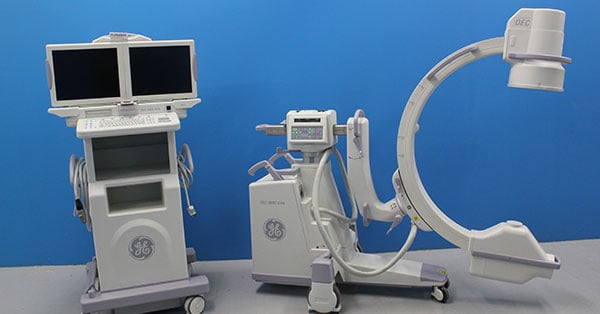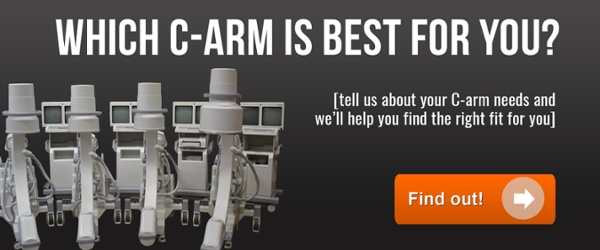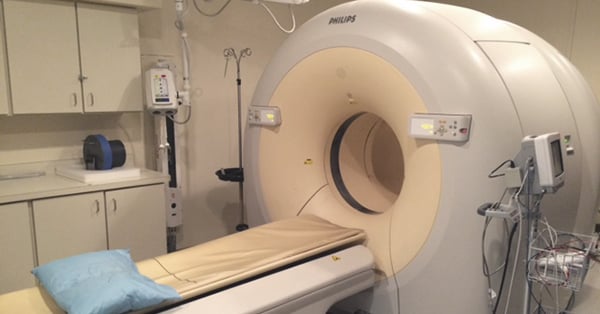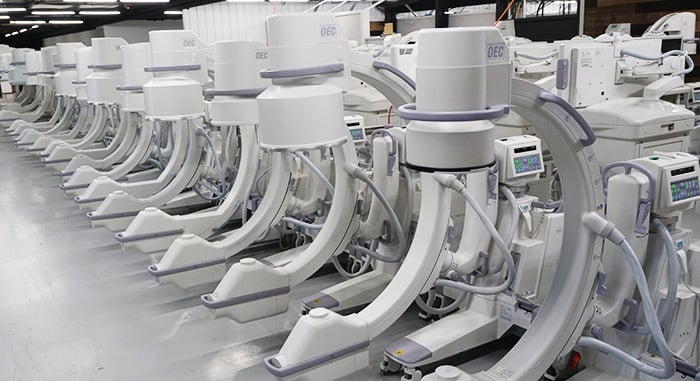
Just a few years ago, Siemens launched their Cios C-arms, debuting new technology that made them a premium product line. Among the Cios units is the flagship, Cios Alpha. With its combination of features and functionality, the Alpha is a compelling package. Still, if you've been in the business for a while, you know that just because there's some new hotness on the market, doesn't mean it's time to kick an older, reliable workhorse to the curb.
So, when it comes to overall value, how does a relative newcomer like the Siemens Cios Alpha stack up against a household name like the OEC 9900? Keep reading to find out.
Siemens Cios Alpha and OEC 9900 C-Arms Compared
Looking solely at technological capabilities, it's really not a fair fight. The Cios Alpha is in a different league with flat detector technology, versus the image intensifier on the 9900. From a power, features, and image quality perspective, the Alpha lives up to its name and wins by a landslide. However, shifting prices, ease and cost of service, and familiar user interfaces are also key factors to consider when deciding which system is the best fit for you.
The Basics
Monitors: When it comes to flexible monitor positioning, the OEC 9900 has an edge via its articulating boom arm. In terms of resolution, however, the Cios Alpha comes out ahead at 4k, versus the 1k monitors of the 9900.
Generators: The Cios Alpha boasts a 25kW generator, while the OEC 9900 is rated at 15kW. This difference allows the Alpha to operate at significantly more power for a more sustained time.
Tubes: The tube of the Cios Alpha is built for power and volume at 5.3 MHU. The 9900's tube is rated much lower at .3 MHU. Paired with the beefy generator, the Alpha is an excellent choice for large patients or busy schedules packed with large patients, lateral abdomen shots, or vascular run-offs.
User Interface: This factor is largely a matter of preference but, considering the long-standing popularity of the 9900 and its similar predecessor, the 9800, there's a strong chance your team already knows the ins and outs of using an OEC system and would experience little to no learning curve bringing a 9900 aboard.
Flat Panel Detector vs. Image Intensifier
Viewing Area: Because the Alpha uses a 12" x 12" square detector instead of a round 12” image intensifier (II), users have about 25-30% more viewing space in each shot.
Dynamic Range: Current flat panel detector technology is estimated to have ten times the dynamic range of II technology. This ability to differentiate between more X-ray intensities makes for cleaner, crisper image details.
Image Degradation: Flat panel detectors don't suffer from the same gradual image degradation that image intensifiers do. While it may be necessary to replace a detector during a Cios Alpha's lifetime, it won't happen nearly as often as replacing the II on an OEC 9900.
Price
With a few more years on the market and a much higher availability from third parties, the OEC 9900 costs far less than the Siemens Cios Alpha. Used 9900s start around $70,000 for more basic configurations. If you add cardiac or vascular features, they can creep as high as the $120,000 range.
Alpha units are far harder to find used. A new Cios Alpha from the OEM runs about $300,000. When you can find one used, expect to spend around $120,000 for a basic package and go up toward $175,000 for fuller features.
Service and Parts
When you compare the cost of parts and service on a 9900 to that of an Alpha, the 9900 comes out on top. There are more parts and engineers available from third parties, and its similarity to the OEC 9800 means there is a lot of crossover. This keeps pricing down for parts, labor, and coverage plans.
The Takeaway
The Siemens Cios Alpha offers more power, more viewing area, and higher image quality than the OEC 9900. These facts can all be seen in a side-by-side look at the hardware. Overall value, however, is a different matter.
While the 9900 isn't as beefy as the Cios Alpha in its tube and generator, it is still hospital grade equipment that can handle the vast majority of complex studies commonly performed on C-arms. And, while there is an image quality advantage in a digital detector, the II has been the standard in C-arms for decades and still delivers well.
We won't go so far as to call the Cios Alpha "over-engineered," but its power and heat capacity have headroom that only the most demanding facilities and schedules will ever touch. For now, while prices are still relatively high on Siemens Cios Alpha systems and the OEM is the most likely (and costly) source for parts and service, we believe a refurbished OEC 9900 provides a better overall value for the average C-arm user.

Chris Sharrock
Chris Sharrock is the Vice President of Healthcare Solutions at Block Imaging. Each day Chris sets out to provide the best equipment, parts, and service solutions for healthcare facilities across the world. Outside of work Chris enjoys playing in a band, and spending time at the lake with his family.






